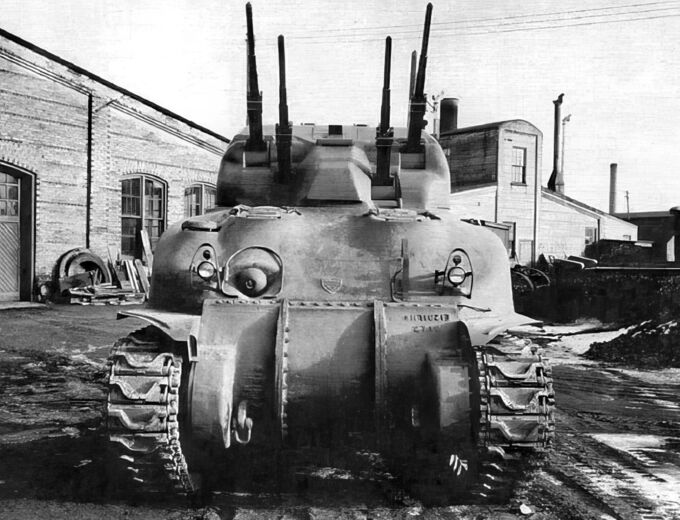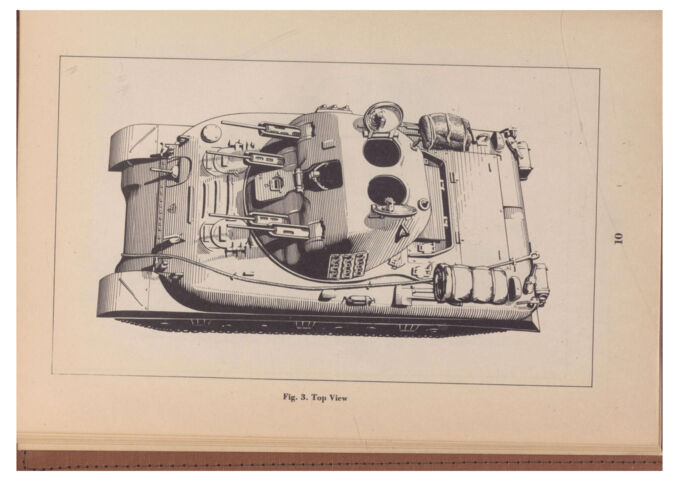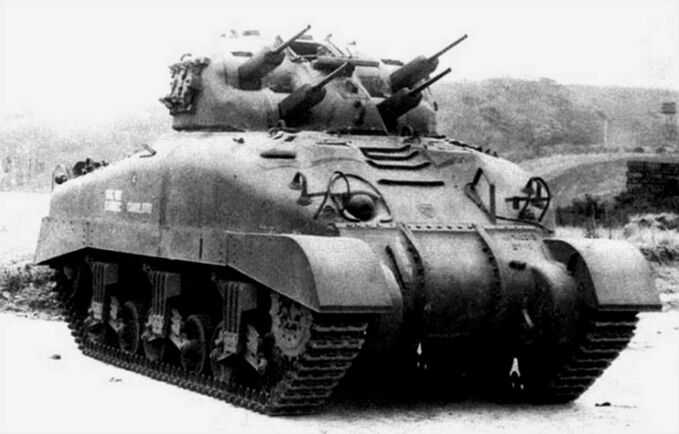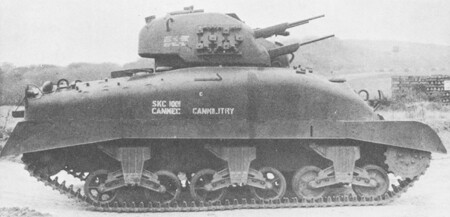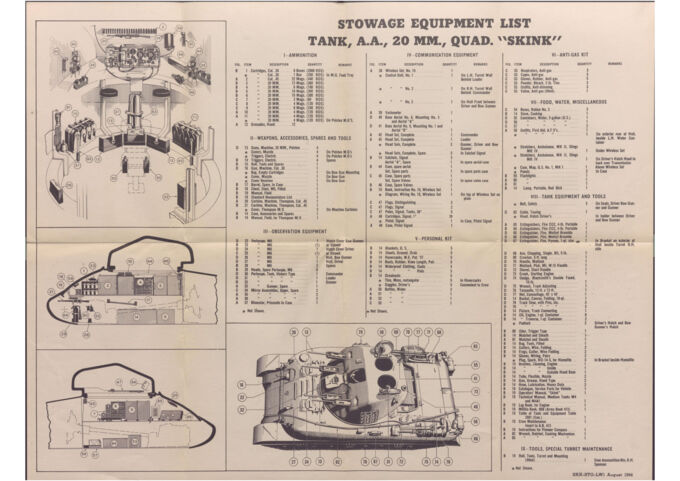The Skink is one of the most iconic Canadian vehicles produced during World War II; the result of Canadian designers' and engineers' concept to fill a role that was required overseas. However, due to setbacks and production limitations, by the time it was ready it was no longer needed. Unlike most delayed projects, the Skink did see service and was operated in the European theater.
Initial development
Requirements
In May of 1943, the G.O.C.-in-C. of the First Canadian Army requested a vehicle be developed that had the following requirements:
- Accommodate 4 guns
- Ammunition stowage for one minute of fire
- 360° traverse at minimum 40° per second and maximum 50° per second.
The requirement for AA at the time could only be filled by using the Crusader or American AA equipment. However, the First Canadian Army did not want to use the Crusader AA, and information requests for American equipment at the time were not forthcoming. The project was assigned project number 47(DVA).
Since Canada was at the time a dominion of Great Britain, a lot of military technologies and reports were shared between them. From the beginning of development, Great Britain and the USA showed great interest in the project. Great Britain’s interest was strong as development of the Crusader AA Mk II had only just began, and the War Office wanted to see which one would end up being better to procure for their forces.
Reclassification
On February 28th, 1944, Project No. 47(DVA) was officially reclassified and given the name “Skink”. The name had been given to the tank before then, however officially it had still been named Project No. 47.
The initial idea was to make turret kits that could be fitted to Shermans; the turrets were initially going to be fitted with a quad Hispano 20 mm gun mount using 50-round boxes, though there were also plans to use a belt-fed system. During development, the armament was swapped to Polsten guns, as requested by the British War Office as well as recommended by the First Canadian Army. This change of armament set back the already delayed development stage of the Skink as they had to redesign the turret to accommodate the Polsten guns.
Production
Great Britain at this time had planned to order 130 turret kits which then turned into 130 complete Skinks; however, in August 1944, they called for a complete cancellation of their Skink orders as they became more interested in the new Grizzly tanks. Following the cancellation of British orders, the entire Skink project was stopped. At this point, only 1 Skink prototype had been completed, with 2 more partially completed — these were later completed, with one retained in Canada and the other, jointly owned by Canada and Great Britain, was sent to Britain for experimental purposes at the request of the Canadian Military Headquarters in London.
Trials
On September 5th, 1944, the Skink prototype (SK1001) arrived in Britain. During that month, the Canadian Military Headquarters also requested that a second Skink be sent. However, due to complications, the second Skink that was to be sent to the UK never left Canada. On September 8th, Canadian Military Headquarters in Great Britain were requested by the Director of the Royal Armed Corps that the Skink be sent to D.T.D. Chobham and then E.W. (G) Lulworth for firing trials. On the 11th of the same month, the Skink was released to head to Chobham. On October 9th, at Chobham, the Skink was demonstrated and went through traverse and elevation tests.
On November 1st, the Canadian army wrote to the Canadian Military Headquarters in London and stated that Great Britain agreed for the jointly-owned Skink, now in Lulworth, to be released to the European theatre for operational trials following the trials at Lulworth, as well as the formation of a unit that would use the vehicle from the Canadian First Army, named the No. 1 Tank Demonstration Unit CAC.
No. 1 Tank Demonstration Unit CAC
The crew of the vehicle and the unit they came from were as follows:
- Captain H Valle — CMHQ
- A/Capt WH Marshell — 3 CACRU
- L54863 A/Sgt Bogden GG — 3 CACRU
- L104991 Tpr Champagne RL — 2 CACRU
- L54863 A/Sgt Bogden GG — 3 CACRU
- L104991 Tpr Champagne RL — 2 CACRU
- B61218 A/SSM Moore TH — 1 CACRU [Substituted for A/SGT Bisson PE before entering the theatre]
- B696338 A/SGT Bisson PE — 3 CACRU
The trials at Lulworth continued from November 1944 to January 1945. Following the trials, the director of the Royal Armoured Corps stated that there was no operational requirement for the Skink in British formations.
Deployment to the European Theater
On January 16th, the Skink was released to the 21st Army Group as part of the First Canadian Army. The Skink was deployed to the European theatre from February until the end of March when it returned to England. While in the theatre, the Skink was unable to be used in the role that it was intended for, due to the lack of aerial opposition by this point in the war. The unit only saw a single enemy aircraft, at a distance that the Skink would not have been able to engage effectively. However, the Skink was found to be effective when used against dug-in enemy infantry positions, in particular with the HEIT incendiary rounds.
The Skink (No.1001) was to be sent back to Canada and one of the Skinks in Canada sent to Great Britain as they wanted to take on the costs of a full Skink rather than 2 jointly owned Skinks. After discussions with Canadian Headquarters in Ottawa, it made more sense that they keep the Skink that was in England rather than swap them. It isn’t fully known what happened to the Skinks in Canada or Great Britain after the war.
Surviving Vehicles
None of the complete vehicles survived after the war, and not everything is fully known about what happened to all of them. However, what is believed to be the third completed vehicle was converted after the war into a Grizzly APC and sent to Portugal as part of NATO Mutual Aid. This was only fully confirmed when the hull was found in storage awaiting disposal in Portugal in 1994. This is based on some markings and distinctive plates/modifications made to the hull itself. It is unknown if the hull has been disposed of, but it can be assumed that it has.
A handful of turrets survived after the war and can still be found in a few locations across Canada:
- 1x Canadian War Museum
- 1x CFB Edmonton Lord Strathcona’s Horse (Royal Canadians)
- 1x CFB Shilo (Royal Canadian Artillery Museum Workshop)
- 1x Okanagan Indian Band War Memorial at Vernon B.C.
